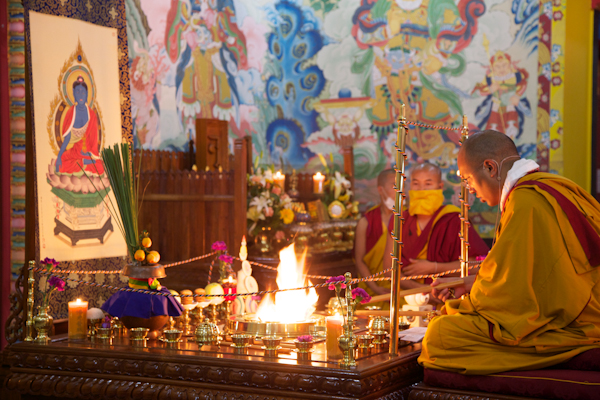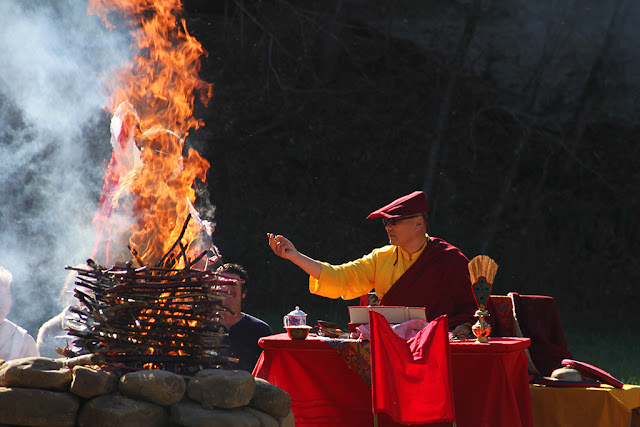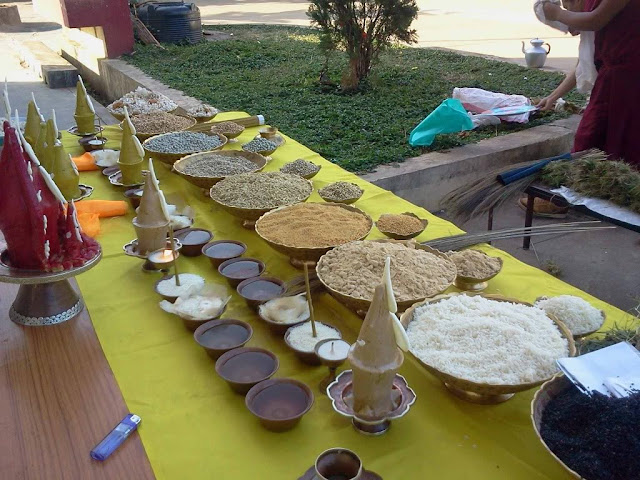During Guru Rinpoche was consecrating the glorious temple Samye, he performed the majestic vajra stance as described in the tantras. This was the very first the ritual dance (cham dances) was created by Guru Rinpoche in the 8th century in Tibet. The original purpose was to remove or destroy the obstacles to the development of Buddhism.
The face masks in Tibetan word is "zhal bag" literally means "likeness of a face" are made in the likeness of the individual deities and worn by the dancers on their faces.
One's outlook when performing a ritual Cham dance, it is taught that when performing ritual dance, you should discard all notions of your ordinary self and assume the divine pride of the deity whose dance you are performing.
The majority can be subsumed within three categories. it is peaceful, wrathful, and semi-peaceful semi-wrathful.
Musical Instruments Accompanying The Dance
The main instruments played to accompany the dances are the cymbals and drum, the long horn, the gyaling (Tibetan oboe), kangling (short horn), the white conch, the hand drum, bell, the silnyen (another type of of cymbal) and the damaru, amongst others. Dancing is rather slow, performed to the accompaniment of drums and cymbals, and sometimes they are joined by trumpet and singing of the Lama.
The Colors of the costumes
The colors vary according to the color of the deity being danced or performed. For example, they may be white, yellow, red, blue,and so on corresponding to the color of the deity and whether the deities are peaceful, magnetizing, wrathful.
The Benefits of Ritual Cham Dance explained in the Tantra
The dance postures, ritual dances, and their many poses.
Should be performed in accord with one's practice and following the texts.
Thereby, the blessings will descend, the mamos and Dakinis will be gathered and influence, wealth, and prosperity. health will increase.
There are many countless benefits to watch the ritual dances.When such ritual dances are being performed at monasteries on special days and occasions,we should go to watch them not for entertainment or fun, but with sincere faith,devotion and right motivation and pure perception. By doing so, it is taught that your temporary and ultimate illnesses, negative influences, and obstacles will be appeased, and you will have a good health, long life, and fulfillment of your wishes and aims.
In the dance the Protectors cut through any obstacles in the coming year, which means clearing away of all the negativities and obstructive forces accumulated over the passing year setting the tone for the coming year to begin a new - with purity, auspiciousness and joy.
A Lama Dance exhibits a mandala of Guru Rinpoche with the blessings from the lineage, it is also called a approach of "See and Enlightened".
Tibetan Buddhist religious dance, performed by masked dancers enacting various religious dramas depicting subjects such as the subjugation of demons. The performance takes a few hours and consists of four parts: pacification and neutralization, subjugating and destruction:-
All dancers are in bright costumes and masks that represent different deities and animals. Costumes for ritual dances are usually sewn from brocade and silk. Wide sleeves of the dresses are shaped like a quiver which symbolizes that the gods concealed a bow and arrows inside the sleeves and at any time will be able to hit enemies.
Today, Lama Dance still has the same purpose. The Lama Dances usually are performed once a year on the 28th & 29th of the last month of the year, before Losar - the Kalachakra Calendar new year, (according to Tibetan lunar calendar).
There are two days of dancing, the first in elaborate robes, the second in full mask and ornate costume and there is another special Lama dance of Guru Rinpoche which is performed on the June 10 of Tibetan lunar calendar.
Tibetan calendar is available, please click here
Thank you for reading, may you find peace and great bliss. With your support it helps to spread the Buddha’s precious teachings and turning the Dharma wheels in the world.
Aspiration For Bodhichitta
For those in whom the precious Bodhichitta has not arisen
May it arise and not decrease
But increase further and further.
Dedication of Merit
By this merit may we obtain omniscience then.
Having defeated the enemies wrong-doings.
May we liberate migratory from the ocean of existence.
With its stormy waves of birth, old age, sickness and death.
*Note
I do not own or infringe any copyright of these pictures.
Pictures courtesy and credit to the rightful distributors and or studios.
Pictures are intended for editorial use only.
Musical Instruments Accompanying The Dance
The main instruments played to accompany the dances are the cymbals and drum, the long horn, the gyaling (Tibetan oboe), kangling (short horn), the white conch, the hand drum, bell, the silnyen (another type of of cymbal) and the damaru, amongst others. Dancing is rather slow, performed to the accompaniment of drums and cymbals, and sometimes they are joined by trumpet and singing of the Lama.
The Benefits of Ritual Cham Dance explained in the Tantra
The dance postures, ritual dances, and their many poses.
Should be performed in accord with one's practice and following the texts.
Thereby, the blessings will descend, the mamos and Dakinis will be gathered and influence, wealth, and prosperity. health will increase.
There are many countless benefits to watch the ritual dances.When such ritual dances are being performed at monasteries on special days and occasions,we should go to watch them not for entertainment or fun, but with sincere faith,devotion and right motivation and pure perception. By doing so, it is taught that your temporary and ultimate illnesses, negative influences, and obstacles will be appeased, and you will have a good health, long life, and fulfillment of your wishes and aims.
In the dance the Protectors cut through any obstacles in the coming year, which means clearing away of all the negativities and obstructive forces accumulated over the passing year setting the tone for the coming year to begin a new - with purity, auspiciousness and joy.
A Lama Dance exhibits a mandala of Guru Rinpoche with the blessings from the lineage, it is also called a approach of "See and Enlightened".
Tibetan Buddhist religious dance, performed by masked dancers enacting various religious dramas depicting subjects such as the subjugation of demons. The performance takes a few hours and consists of four parts: pacification and neutralization, subjugating and destruction:-
2) Neutralization is the process of offering to the obstacles so that they have a substitute for their aggression.
3) Subjugating is threatening the obstacles with destruction should they not obey, represented in the dancing by displaying a series of weapons.
4) Destruction culminates in shooting an arrow of fire into a large torma that contains all obstacles.
Dancing is rather slow, performed to the accompaniment of drums and cymbals, and sometimes they are joined by trumpet and singing of the Lama.
Today, Lama Dance still has the same purpose. The Lama Dances usually are performed once a year on the 28th & 29th of the last month of the year, before Losar - the Kalachakra Calendar new year, (according to Tibetan lunar calendar).
There are two days of dancing, the first in elaborate robes, the second in full mask and ornate costume and there is another special Lama dance of Guru Rinpoche which is performed on the June 10 of Tibetan lunar calendar.
Tibetan calendar is available, please click here
Thank you for reading, may you find peace and great bliss. With your support it helps to spread the Buddha’s precious teachings and turning the Dharma wheels in the world.
Aspiration For Bodhichitta
For those in whom the precious Bodhichitta has not arisen
May it arise and not decrease
But increase further and further.
Dedication of Merit
By this merit may we obtain omniscience then.
Having defeated the enemies wrong-doings.
May we liberate migratory from the ocean of existence.
With its stormy waves of birth, old age, sickness and death.
*Note
I do not own or infringe any copyright of these pictures.
Pictures courtesy and credit to the rightful distributors and or studios.
Pictures are intended for editorial use only.


































